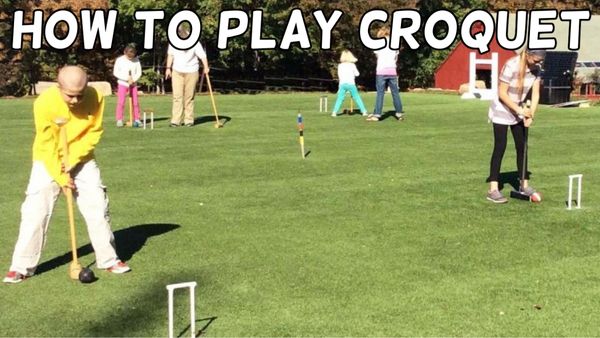
This article can help you if you’d like to learn how to play croquet or how to play croquet simple, get better at it, or just figure out how to maintain score. You may learn how to play 9-Wicket Croquet, how to score a wicket, and what supplies you’ll need to participate in this well-liked sport. To learn all you need to play croquet, continue reading.
Although played all across the world, croquet is possibly the most distinctly English game there is. What could be more enjoyable on a rare sunny day in England than a game of croquet, a drink of Pimm’s, as well as a cucumber sandwich? Perhaps a lot of things, but let’s check at the rules nevertheless!
Although there is evidence that comparable games were played as early as the 1600s, the first set of croquet rules was only officially registered in 1856. The game has many distinct variations, and various regions of the world have adopted somewhat different versions. However, in their most basic form, they all entail using a wooden mallet to strike balls over a prepared grass through hoops. Here, we’ll focus on the World Croquet Federation’s Official Rules of Garden Croquet.
Rules of CROQUET
- Blue, Red, Black, as well as Yellow are the four balls; they must be played in that sequence (the colors are painted on the center peg to act as a reminder).
- To make the game more convenient, the hoops, peg, as well as other balls cannot be moved.
- The striker is the player whose turn it is to play. One strike makes up one turn. One player uses the red and yellow balls while the other utilizes the blue and black balls in singles. Each participant in the doubles game hits their own ball, with blue partnering black and red partnering yellow.
- To begin the game, flip a coin. The sequence of play, as shown on the centre peg, is blue, red, black, and yellow. The winner must strike first with the blue ball.
- Everybody begins on the court one yard away from the corner closest to hoop 4. You strike your ball from where it lays in subsequent revolutions. Hoops one and two should be run in the order shown on the diagram.
- Everyone then tries to run hoop 2, and so on, once someone has ran hoop 1. The first person to run 7 hoops wins the game. The game is played out in the order depicted.
- When no portion of the ball extends over the side of the hoop from where it originated, the hoop is considered to have run (see the diagram) Running a hoop may require more than one spin for a ball.
- Even if the striker’s ball also passes through the hoop, the hoop counts or score for the ball that was peeled if a ball other than the striker’s ball is struck through it.
- In order to complete a turn, you must only use the mallet’s face to strike the designated ball. It counts as a strike if you accidentally contact your ball. You cannot “pass” when it is your turn; you must take the opportunity.
- Avoid touching any other balls with your mallet when striking your ball since doing so results in a “fault.” Additionally, it’s improper to “double tap” your own ball or “crush” it into the hoop or the peg. If your ball is close to an upper of a hoop and at an angle to the opening, extreme caution must be exercised to avoid these mistakes. No matter what, forcing the ball through is wrong!
- If a mistake is made, the round is over, no points are awarded, and your opponent has the option of starting his turn from where the balls are or having them put back where they came from.
- You must avoid touching or letting be touched by any ball, even if it’s not your turn, or you will forfeit your next turn. So be careful not to trip over a ball, and be aware of moving balls. They are quick on their feet! If you touch a ball, your opponent has the option of leaving it where it lands or returning it to its original position.
- It’s important to avoid playing the wrong ball or out of turn. If this does occur, your opponent has the option to decide whether to start again with a different ball or to keep the current set of balls. For instance, if yellow was (incorrectly) played after blue, your opponent might choose to play either the black or blue ball to continue. A hoop point is not awarded when the incorrect ball runs through it.
- Any ball that has strayed off the field must be replaced on the boundary where it went off.
- Any ball that is more than half way to the next hoop to be played once a turn that results in a hoop point is scored can be termed “offside,” unless it gets there:
- As a result of the stroke that was just performed, such as when it runs through the hoop, is peeled through, or peels another ball through the hoop;
- As a result of an opponent’s stroke, such as when the red ball is struck and moves the opponent’s blue or black ball over the halfway point to the following hoop;
- By the striker’s ball travelling past halfway to the next hoop after deflecting off an opponent’s ball.
When ordered to transfer the ball to one of two penalty spots because it is offside and has been claimed by your opponent, you have to select which one. The halfway marks on each of the longer borders are the penalty points. Your opponent could prefer that you begin your turn from the location of your ball.
Scoring in croquet
In association croquet, from which garden croquet is sprung, you may earn up to 14 points by getting every ball through every hoop and an additional point for striking the peg with every ball.
Winning the Game
A team or individual wins if they first score 14 points, which is accomplished by pegging each ball out after passing both balls through all six hoops.
Players and equipment in croquet
The rules of croquet are the same whether the game is played one versus one (singles) or two against two (doubles). The red and yellow balls are 3 inches in diameter & weigh one pound, with black and blue balls being used by one side and the red and yellow balls by the other teams.
Each participant also requires a wooden mallet to hit the balls with in addition to the balls themselves. There aren’t many rules for the mallet, although they typically weigh 2.5–3.5 pounds, measure 24–40 inches long, and have a square face, however round faces can also be used.
The lawn is typically 17.5 by 14 metres, although any sizeable, generally smooth grassy area would do for the casual player. A typical lawn may be as large as 32 m x 25.6 m in croquet clubs where the grass is shorter and consequently moves more quickly. The crucial factor is maintaining about the same proportions.
Metal hoops that are 12 inches high and 334 inches wide—barely wider than the balls—are used for competitive play.
The hoops are arranged in a predetermined pattern, generally with numbers one and two on the left side at each end, three and four on the right side, five and six in the middle, and a little bit closer to the peg in the centre that is used for the start and conclusion of the game.
The tactics used in the game of croquet
Croquet is a difficult game that involves method and strategy. Croquet Tactics, a thorough explanation of the game’s regulations, was written by John Riches and released in 1991. The equipment, regulations, and playing styles of the game are all covered in this book. A game of balance and equilibrium is croquet. The game may be played with two, four, or even six people. The object of singles play is to put the ball through a series of six hoops. The center peg must be hit for the team to win. It is referred to as the “central peg.”
9-Wicket Croquet
9-Wicket Croquet’s fundamental rules are not too complex. The dimensions of the court should be 50 feet long by 100 feet broad, with shorter ends measuring 25 or 30 feet. There will be a 2:1 ratio between the longer and shorter measurements. Stakes, flags, or pebbles will be used to indicate the shorter end. The short side’s centerline serves as the court’s focal point. The center of the court must be reached by the players travelling the necessary distance.
- Paytm First Game: Why Should You Choose Paytm First Games App?
- These 6 upcoming WhatsApp features will change the texting game forever
- Snap adds Ghost Phone AR game to Snapchat
The wickets should be positioned on the court with their openings towards the shorter sides. You might need to shift the wickets a little bit to level out an uneven arrangement.
Additionally, three wickets and two stakes can be used to play croquet. For this game, you should pick a mallet that both beginners and experts can use because it isn’t too heavy.
Conclusion
The game of croquet could be the one that most closely resembles England. Only in 1856 were the original croquet rules formally recorded. They all entail striking balls over prepared grass with a wooden mallet in their most basic forms. Here, we concentrate on the Garden Croquet Official Rules published by the World Croquet Federation. The hoop is said to have run when no piece of the ball crosses over the side from where it first entered.
A ball may need to spin more more once to “pass” through a hoop, thus you must seize the chance to do so. Whether the game is played one against one (singles) or two against two, the rules of croquet remain the same (doubles). A team






